Sandy Bridge-E and X79 – The ASUS P9X79 PRO Review
by Ian Cutress on November 14, 2011 3:01 AM EST- Posted in
- Motherboards
- Asus
- X79
USB Speed
For this benchmark, we run CrystalDiskMark to determine the ideal sequential read and write speeds for the USB port using our 64GB Patriot SuperSpeed USB 3.0 drive. Then we transfer a set size of files from the SSD to the USB drive, and monitor the time taken to transfer. The files transferred are a 1.52 GB set of 2867 files across 320 folders – 95% of these files are small typical website files, and the rest (90% of the size) are the videos used in the Sorenson Squeeze test.


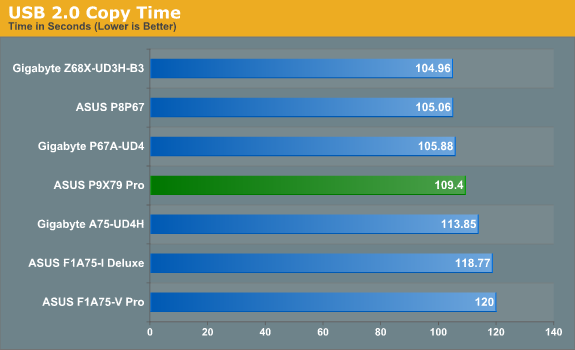
Unfortunately, we ran into an issue with our USB 3.0 stick after the USB 2.0 tests. For some reason it is no longer being detected properly. When we get a replacement, the graphs shall follow.
SATA Testing
We also use CrystalDiskMark for SATA port testing. The operating system is installed on the Micron RealSSD C300, which is rated at 355 MB/s read and 215 MB/s write, and the sequential test is run at the 5 x 1000 MB level. This test probes the efficiency of the data delivery system between the chipset and the drive, or in the case of additional SATA ports provided by a third party controller, the efficiency between the controller, the chipset and the drive.
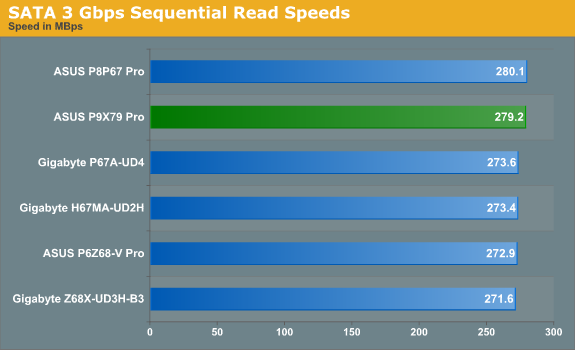
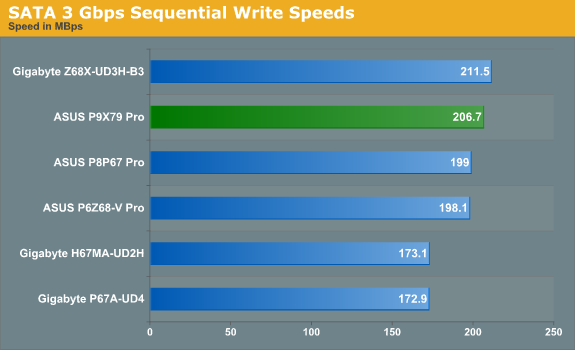
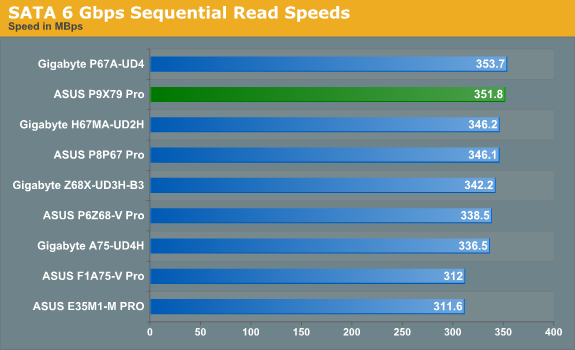
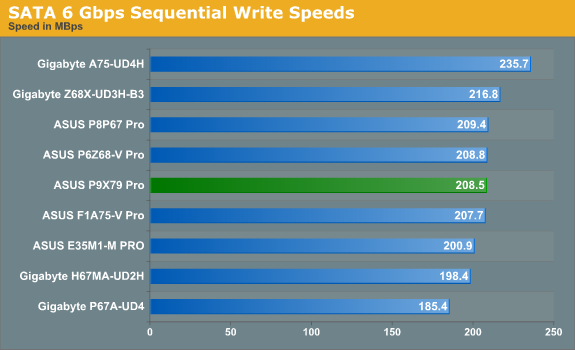
Overall, the PCH does well in SATA sequential speeds compared to previous platforms.
DPC Latency
Deferred Procedure Call latency is a way in which Windows handles interrupt servicing. In order to wait for a processor to acknowledge the request, the system will queue all interrupt requests by priority. Critical interrupts will be handled as soon as possible, whereas lesser priority requests, such as audio, will be further down the line. So if the audio device requires data, it will have to wait until the request is processed before the buffer is filled. If the device drivers of higher priority components in a system are poorly implemented, this can cause delays in request scheduling and process time, resulting in an empty audio buffer – this leads to characteristic audible pauses, pops and clicks. Having a bigger buffer and correctly implemented system drivers obviously helps in this regard. The DPC latency checker measures how much time is processing DPCs from driver invocation – the lower the value will result in better audio transfer at smaller buffer sizes. Results are measured in microseconds and taken as the peak latency while cycling through a series of short HD videos - under 500 microseconds usually gets the green light, but the lower the better.

As with the faster processor, we are expecting better DPC Latency as long as the system is engineered quickly. Our max result here was 116 microseconds, however this was a blip - for most of the time, the board would hover around 30 microseconds, which is an excellent result.










55 Comments
View All Comments
markgerazzi - Saturday, November 19, 2011 - link
Also very important, will the Noctua D14 fan block or compromise any of the 8 DImm slots?THanks!
CodeToad - Friday, December 2, 2011 - link
I know my workstations... they had to pry my Sun 20 out of my dying hands! All the P9X79 lacks as a true workstation are SAS+SATA control and some Intel virtualization and net tech, at least on the WS model. That would have been easy to add, and I'm sorry Asus failed to go the extra step with the WS model.The P9X79 lacks nothing that I can see for the enthusiast - in fact there are huge possibilities for overclocking, tweeking, water cooling, and improvement via add-on boards.
There is the issue of threading in current games. Worry not! Every developer I know is urgently learning to improve their code at compile time, including deeply threading applications.
Yes, the board is expensive. So are all the rest in the Top Tech arena. I've looked for another board for the i7-3960X class, and can't find anything cheaper on balance. My experience with Asus build quality and their warranty are final decision factors for me.
I urgently need to build a machine for home office use. I do heavy OLAP and Data Mining research, and I contribute to open source -- the R project and others. I'm also a heavy WS virtualization user. Whatever I choose will be feed by two mid-range servers on a cheap switched 1K+ network, my total "IT Dept." Soon I will have to learn CUDA, and this board will serve will with the right video, since behind the visualization is a ton of computation.
Yes, I could build a server-like box, but I think this board, tons of fast switched memory, and the Core i7-3960X CPU may do better than a traditional dual machine. I'll have to add some boards, but that would be required with any motherboard.
So it's a bit of a risk, but I'm sold.
Thus to all -- if you want to "pee on the tall weeds with the big dogs," the P9X79 is the board and the Intel I7-39x0 is the CPU to do it.
InfiDELL - Thursday, December 8, 2011 - link
While X38 was really something over P35 and P45 from X58 to X79 eve I can't see a difference that will worth the money invested in 1366,1356 socket boards.The extra USB or the power to tweak a CPU that already doesn't have enough backbone for his power?
Or the extra bandwidth of VGA which is so small vs the high price of this boards and CPU.
Not to say it consume more Watts than sandy.
I really scrambled my brains to find the advantages of this boards in IO and ram latency over 1155 boards but, I can't really see but very small differences in performance and with what cost.
I expected that triple channel , quad channel and the native sata 6gb will really tell me something on so called enthusiastic boards. So the CPU and whole system will benefit from lower RAM latency and the rest need it for a big brain as latest CPUs are capable off.
I expected that SB on X79 will really get in flames of so much IO but no, it only burning your pocket for more multicolored heat-sink or some worthless shape.
In top of all extra expenses we get the power bill higher as this boards + their CPU consume quiet more.
Coming back to x38, yes is better than P45 and consume about 25 watts more but, easy taken by P965 in performance and power consumption and for me P965 remain the king of DDR 2 platforms as I tested Asus P5EWS pro X38 , Abit quad GT P965, asus P5K deluxe P965 and Maximus II P45.
History repeat itself.
I'll go prolly to a common 1155, is not worth to wait for X79 CPUs to go down in price as this boards are not shining for me and the same for 1366.
Very disappointing results but thank you for tests it's clear again for me10th time now is not really a deal but, a rip off.
dgingeri - Friday, January 13, 2012 - link
I have a need for lots of memory, even up to 32GB: virtual machines. My current virtual host system (Core i7 950) has 12GB, and I run several small virtual machines for my MCITP testing prep. I currently have 2 domain controllers, a SQL server, an Exchange server, a WDS and WSUS system, and 2 virtual workstations, all to practice for my MCITP tests. (Now I just need to get the money to actually take the tests. 9 tests are pretty expensive.) It's well worth the time and money to get a system like this for that purpose. It's even more cost effective than classes for me.candabi - Thursday, January 26, 2012 - link
I'm looking for a soho server for Virtualize several machines so, I like this Mobo for its 8 memoriy slots, but Is it possible to install Win2K8 w/o any problem?I want to use the teaming functionallity of my Synology iSCSI NAS with two LAN ports.
So, I am thinking on purchase one DUAL LAN card, or two separated LAN cards in order to connect them directly to NAS.
And the integrated LAN, it could be connected to the USERS SWITCH.
Do you think is possible? What DUAL LAN card do you recommend?
Tks